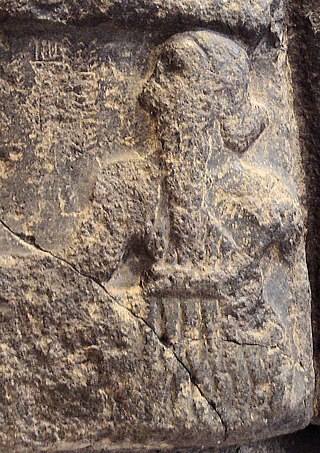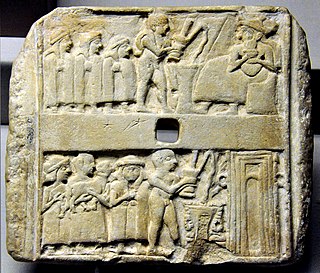Related Research Articles
Akkadian literature is the ancient literature written in the Akkadian language in Mesopotamia during the period spanning the Middle Bronze Age to the Iron Age.

Nergal was a Mesopotamian god worshiped through all periods of Mesopotamian history, from Early Dynastic to Neo-Babylonian times, with a few attestations indicating that his cult survived into the period of Achaemenid domination. He was primarily associated with war, death, and disease, and has been described as the "god of inflicted death". He reigned over Kur, the Mesopotamian underworld, depending on the myth either on behalf of his parents Enlil and Ninlil, or in later periods as a result of his marriage with the goddess Ereshkigal. Originally either Mammitum, a goddess possibly connected to frost, or Laṣ, sometimes assumed to be a minor medicine goddess, were regarded as his wife, though other traditions existed, too.

Sin or Suen (Akkadian: 𒀭𒂗𒍪, dEN.ZU) also known as Nanna (Sumerian: 𒀭𒋀𒆠DŠEŠ.KI, DNANNA) was the Mesopotamian god representing the moon. While these two names originate in two different languages, respectively Akkadian and Sumerian, they were already used interchangeably to refer to one deity in the Early Dynastic period. They were sometimes combined into the double name Nanna-Suen. A third well attested name is Dilimbabbar (𒀭𒀸𒁽𒌓). Additionally, the moon god could be represented by logograms reflecting his lunar character, such as d30 (𒀭𒌍), referring to days in the lunar month or dU4.SAKAR (𒀭𒌓𒊬), derived from a term referring to the crescent. In addition to his astral role, Sin was also closely associated with cattle herding. Furthermore, there is some evidence that he could serve as a judge of the dead in the underworld. A distinct tradition in which he was regarded either as a god of equal status as the usual heads of the Mesopotamian pantheon, Enlil and Anu, or as a king of the gods in his own right, is also attested, though it only had limited recognition. In Mesopotamian art, his symbol was the crescent. When depicted anthropomorphically, he typically either wore headwear decorated with it or held a staff topped with it, though on kudurru the crescent alone served as a representation of him. He was also associated with boats.

Marduk was a god from ancient Mesopotamia and patron deity of the city of Babylon who eventually rose to power in the First Millennium BCE. In the city of Babylon, Marduk was worshipped in the temple Esagila. His symbol is the spade and he is associated with the Mušḫuššu.

Shamash was the ancient Mesopotamian sun god, earlier known as Utu. He was believed to see everything that happened in the world every day, and was therefore responsible for justice and protection of travelers. As a divine judge, he could be associated with the underworld. Additionally, he could serve as the god of divination, typically alongside the weather god Adad. While he was universally regarded as one of the primary gods, he was particularly venerated in Sippar and Larsa.The moon god Nanna (Sin) and his wife Ningal were regarded as his parents, while his twin sister was Inanna (Ishtar). Occasionally other goddesses, such as Manzat and Pinikir, could be regarded as his sisters too. The dawn goddess Aya (Sherida) was his wife, and multiple texts describe their daily reunions taking place on a mountain where the sun was believed to set. Among their children were Kittum, the personification of truth, dream deities such as Mamu, as well as the god Ishum. Utu's name could be used to write the names of many foreign solar deities logographically. The connection between him and the Hurrian solar god Shimige is particularly well attested, and the latter could be associated with Aya as well.
Mamitu was a Mesopotamian goddess associated with the underworld. She was regarded as the wife of Nergal, or sometimes of other gods regarded as analogous to him, such as Erra. Her importance in Mesopotamian religion was minor, and she was most likely chiefly worshiped in Kutha, though attestations are available from other cities too. It is possible that she was the forerunner of Mandean Amamit.

Ninurta (Sumerian: 𒀭𒊩𒌆𒅁: DNIN.URTA, possible meaning "Lord [of] Barley"), also known as Ninĝirsu (Sumerian: 𒀭𒎏𒄈𒋢: DNIN.ĜIR2.SU, meaning "Lord [of] Girsu"), is an ancient Mesopotamian god associated with farming, healing, hunting, law, scribes, and war who was first worshipped in early Sumer. In the earliest records, he is a god of agriculture and healing, who cures humans of sicknesses and releases them from the power of demons. In later times, as Mesopotamia grew more militarized, he became a warrior deity, though he retained many of his earlier agricultural attributes. He was regarded as the son of the chief god Enlil and his main cult center in Sumer was the Eshumesha temple in Nippur. Ninĝirsu was honored by King Gudea of Lagash (ruled 2144–2124 BC), who rebuilt Ninĝirsu's temple in Lagash. Later, Ninurta became beloved by the Assyrians as a formidable warrior. The Assyrian king Ashurnasirpal II (ruled 883–859 BC) built a massive temple for him at Kalhu, which became his most important cult center from then on.

Anzû, also known as dZû and Imdugud, is a monster in several Mesopotamian religions. He was conceived by the pure waters of the Abzu and the wide Earth, or as son of Siris. Anzû was depicted as a massive bird who can breathe fire and water, although Anzû is alternately depicted as a lion-headed eagle.
Ilabrat was a Mesopotamian god who in some cases was regarded as the sukkal of the sky god Anu. Evidence from the Old Assyrian period indicates that he could also be worshiped as an independent deity.
The earliest record of a Sumerian creation myth, called The Eridu Genesis by historian Thorkild Jacobsen, is found on a single fragmentary tablet excavated in Nippur by the Expedition of the University of Pennsylvania in 1893, and first recognized by Arno Poebel in 1912. It is written in the Sumerian language and dated to around 1600 BC. Other Sumerian creation myths from around this date are called the Barton Cylinder, the Debate between sheep and grain and the Debate between Winter and Summer, also found at Nippur.

Sargon of Akkad, also known as Sargon the Great, was the first ruler of the Akkadian Empire, known for his conquests of the Sumerian city-states in the 24th to 23rd centuries BCE. He is sometimes identified as the first person in recorded history to rule over an empire.

Sumerian religion was the religion practiced by the people of Sumer, the first literate civilization of ancient Mesopotamia. The Sumerians regarded their divinities as responsible for all matters pertaining to the natural and social orders.
Ašratum was a Mesopotamian goddess of Amorite origin. She was regarded as the wife of the god Amurru. Her name is a cognate of Ugaritic Athirat, but despite likely sharing the same origin these two goddesses occupied different positions in the respective pantheons.
An = Anum, also known as the Great God List, is the longest preserved Mesopotamian god list, a type of lexical list cataloging the deities worshiped in the Ancient Near East, chiefly in modern Iraq. While god lists are already known from the Early Dynastic period, An = Anum most likely was composed in the later Kassite period.
Weidner god list is the conventional name of one of the known ancient Mesopotamian lists of deities, originally compiled by ancient scribes in the late third millennium BCE, with the oldest known copy dated to the Ur III or Isin-Larsa period. Further examples have been found in many excavated Mesopotamian cities, and come from between the Old Babylonian period and the fourth century BCE. It is agreed the text serverd as an exercise for novice scribes, but the principles guiding the arrangement of the listed deities remain unknown. In later periods, philological research lead to creation of extended versions providing explanations of the names of individual deities.

The Akkadian composition Advice to a Prince, also known as Babylonischer Fürstenspiegel, calls on future kings and magnates to heed justice. More particularly, it exhorts them to respect the special status of the three ancient Babylonian cities Sippar, Nippur and Babylon, whose citizens are presented as exempted from forced labor and taxes by divine decision. In a casuistic structure reminiscent of both law and omen treatises, the text lists the divine punishments reserved for the powerful who do not abide by its clauses.
The "Series of the Poplar" is an Akkadian disputation poem containing a discussion between a Poplar, an Ash, and probably other trees, who each tries to establish his preeminence in the vegetal kingdom by listing their many uses and excellent qualities. Most of the surviving examples of the work are from the library of King Assurbanipal of Nineveh, "one of the most important repositories of texts from the entire ancient world".
The Series of Ox and Horse is a work of literature written in the Akkadian language. It contains a poetic dispute between an ox and a horse and perhaps other animals. Around 200 mostly fragmentary verses are known, but it is uncertain how long the text originally was, or in which order the preserved fragments should be arranged.
Palm and Vine is a work of Akkadian literature. It contains a disputation poem between two litigants, Palm and Vine, each of which praises its own merits and many uses, and discredits those of its rival. The text may have been composed in the second-millennium BCE, but only first-millennium manuscripts of it are known. Fifty-four lines from the middle section of the text are preserved, which begin in medias res with a long speech of Palm, immediately followed by Vine's rejoinder. Three library manuscripts of the poem are known, as well as an excerpt on a peculiar school tablet.
The Catalogue of Texts and Authors is a work of Akkadian literature. The Catalogue represents the most important Mesopotamian metatext: its compiler grouped together texts or text categories under the names of authors "from whose mouth" they purportedly stem. Works are ascribed to Ea, to antediluvian sages and semi-mythical kings; but also to famous family ancestors and scholars from a less remote past. Additionally, some compositions are said to result from divine revelation or from dictation by certain animals.
References
- ↑ "electronic Babylonian Library". Ludwig Maximilian University of Munich.
- ↑ Jiménez, Enrique (2017-02-06). The Babylonian Disputation Poems: With Editions of the Series of the Poplar, Palm and Vine, the Series of the Spider, and the Story of the Poor, Forlorn Wren. BRILL. pp. 327–376. doi:10.1163/9789004336261. ISBN 978-90-04-33626-1.